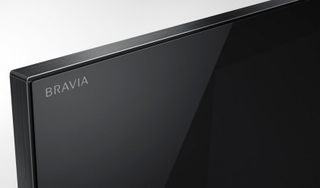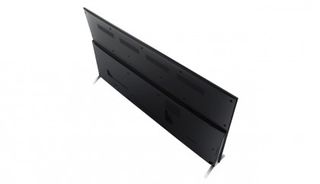Why you can trust TechRadar
While I may have misgivings about the wisdom of Sony adopting the Android TV smart system, I have no misgivings at all about its picture quality.
It is, in a word, magnificent.
There's so much great stuff going on it's hard to know where to start. But as it's the area where the 75X9405C may turn out to be particularly good versus even other sets in Sony's range, let's go for its contrast performance.
Thanks to its use of a direct LED lighting system and local dimming, where the TV can output different light levels from different sections of LEDs ranged directly behind the TV's screen, the 75X9405C delivers a sublime combination of rich, inky black colours and bold, vibrant colours.
Pictures erupt off the screen with a dynamism edge-lit LCD TVs can really only dream about.
Unfortunately the HDR update for the 75X9405C isn't available yet, but it's not hard to imagine HDR producing spectacular results on a TV with such a superb light engine as this. Even though, to sound a word of caution, unlike Samsung's SUHD TVs the 75X9405C wasn't designed from the ground up to handle HDR.

Triluminos does the business
The 75X9405C's colour performance deserves more credit than just describing it as a function of the TV's spectacular contrast.
It's clear from the spectacular range and achingly gorgeous colour subtlety on show with native 4K content that Sony's boasts about its new Triluminos/X1 processing combination are far from mere idle marketing banter.
So deft is the colour performance, in fact, that the 75X9405C delivers arguably the most 4K picture I've ever seen on a 4K TV - if you see what I mean.
I'm not just referring to colour precision or simple levels of detail with that statement either.
Sony's 4K prowess can also be felt in the extent to which you become immersed in native 4K images, and in the way the screen delivers so profound a sense of depth (thanks to the ability to render fine detail further into the distance and the exceptional colour delineation) that at times you feel like you're watching 3D without needing any glasses.
Poetry in motion
The stellar purity and sharpness of the 75X9405C's 4K pictures remains mercifully intact when you're watching action scenes or sport, too.
The screen's native motion performance without processing in play is better than most, but Sony's motion processing this year is good enough if you choose to use it to remove almost all blur and judder while suffering practically no unwanted digital side effects. There are even a number of slightly different but all effective (in their own ways) motion settings you can experiment with.
The 75X9405C also impresses greatly with its adaptability. The advances delivered by its X1 processor enable it to handle a hugely diverse range of different non-4K content types much more ably than most 4K UHD TVs currently can - even more ably in most ways, in fact, than they were handled by Sony's excellent 2014 X9005B 4K TVs.
The only reason I qualified that last statement is that while for most of the time the incredible extra sharpness and detail Sony's processing injects into HD sources is a joy to behold, it can sometimes struggle with particularly grainy sources, making the grain feel more dominant and 'alive' than it should be.
Fortunately there's a pretty easy fix for this issue if you become aware of it, though: simply choose the manual setting for Sony's Reality Creation feature and reduce the Resolution setting until the noise subsides to tolerable levels.

Looking good right of the box
Don't think from this last paragraph, though, that the 75X9405C is in any way a chore to set up.
On the contrary, for the most part it's so good at recognising and automatically adapting its picture settings to different source types that you can just kick back and soak up the beauty, with no need to get manually involved in set up at all.
I'm not saying you can't improve things even more with a little manual intervention, but I can't think of any other TV that takes so much care out of the box to ensure that its pictures harmonise with the specific abilities of its screen.
This is hugely preferable to the more aggressive 'showing off' exhibited by most rival TVs using their out-of-the-box settings.
It's worth adding at this point that the 75X9405C's picture skills are merely underlined by the enormity of its 75-inch screen. A screen size at which, of course, there can be no hiding place for imperfections.
3D
The 75X9405C's enormity makes it well suited to the immersive experiences offered by good quality 3D transfers too, so it's great to find Sony's set cashing in on this simple 'size matters' appeal with a 3D picture that looks dynamic, full of depth, richly coloured, bright and less affected by crosstalk ghosting noise than many of Sony's previous active 3D TVs.
There is, to be clear, still a little crosstalk around distant and/or sharply contrasted objects, and I also didn't feel that the 75X9405C's 3D pictures looked quite as pristinely detailed and sharp as its upscaled 2D ones.
But nonetheless there aren't many more impressive 3D experiences to be had in the TV world right now than the one you get here.
While brilliant, though, not even the 75X9405C's pictures are perfect. As noted already, Sony's upscaling engine can occasionally get a bit over-enthusiastic with grainy sources. Though you can work round this.

Minor brickbats
Also, the glassy look to the screen causes a few issues with reflections - though to be fair to Sony, it fares better in this regard than some of Samsung's current screens.
Especially its curved ones.
If you find yourself having to watch the 75X9405C from a widish viewing angle then you may become aware of some light 'haloing' around bright objects, at least when they appear against dark backdrops.
Actually you can also become aware of some very slight light 'bleed' around areas of really extreme contrast even when watching from straight on - especially if you're trying to run the TV too brightly or what you're watching uses a widescreen format with black bars above and below.
Running the 75X9405C directly alongside a Samsung 65JS9500 reveals, too, that Sony's set isn't as bright or as capable of delivering such pristine, pure whites as Samsung's.
This raises potential questions over the Sony model's HDR credentials - though the 75X9405C's richer colour palette with non HDR content may prove to be an adequate compensation.
We'll try and get another look at the 75X9405C when the HDR update is available.
Current page: Picture Quality
Prev Page Introduction and features Next Page Usability, Sound and ValueJohn has been writing about home entertainment technology for more than two decades - an especially impressive feat considering he still claims to only be 35 years old (yeah, right). In that time he’s reviewed hundreds if not thousands of TVs, projectors and speakers, and spent frankly far too long sitting by himself in a dark room.


